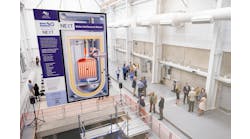A summer camp in Frederick, Maryland is operating a campus microgrid that leverages Property Assessed Clean Energy (PACE) to achieve an immediate return on investment while delivering green energy.
The net zero carbon microgrid serves Bar-T Mountainside Summer Camp, a 115-acre campus that offers after-school childcare, summer day camps, outdoor education and corporate team building and events.
The microgrid project stands out as the first commercial and industrial facility in Frederick County to employ PACE, a program that allows property owners to finance the up-front cost of energy projects and pay the costs back over time with their property taxes.
“It was designed to be cash-flow positive on day one — savings are greater than the PACE debt service. Thus, the system delivers 100% green power, resiliency and ‘savings as-a-service’,” said Brent Hollenbeck, founder and CTO of TimberRock Advanced Energy, which leads the project.
The system is designed to produce energy savings, energy resilience and new opportunities to generate revenues via market arbitrage.
Campus microgrid delivers 100% green energy
Bar-T’s microgrid has roughly 100 kW of PV across the facility’s various roof tops. Three separate distributed battery systems collectively provide about 35 kWh of energy storage capacity, according to TimberRock.
All of the PV arrays are islandable and capable of operating independently during grid outages.
“Thus, the battery was sized for night time and the PV system can continue to produce energy during the day even during a multi-day grid outage,” said Brent Hollenbeck, TimberRock founder and CEO. “Said plainly, the power and energy capacity of the system should be sufficient to power the entire campus as a microgrid in a 100% ‘green’ manner even during an extended grid outage.”
In addition, the cyber secure microgrid boosts the camp’s ability to protect private records about schools, schoolchildren and families, as well as its own operations.
No corner overlooked
Brought online on September 16, the campus microgrid is the latest in a long line of sustainability initiatives Bar-T has carried out over the past decade.
“Like many environmentally conscious organizations, Bar-T has a long history of deploying clean energy technologies. This commitment, and multiple investments over the years, has allowed the Bar-T team to learn multiple lessons about what does and doesn’t make sense in regard to its mission, goals and financial capacities,” Hollenbeck said.
The camp addresses greenhouse gas emissions from buildings via energy efficiency efforts and for transportation by way of electric vehicle charging infrastructure.
The microgrid’s renewable energy reources, along with its sophisticated connectivity, control and monitoring systems, further enhance the camp’s green profile.
“No corner of the facility was overlooked and a suite of renewable generation, efficiency, resiliency and connectivity technologies via Blue Pillar will be deployed to achieve net zero as well as microgrid capabilities,” Hollenbeck said.
Tracking energy use in real-time
The campus microgrid uses Blue Pillar’s grid-edge IoT connectivity and control platform to gather and move real-time energy data from Bar-T’s electrical system into TimberRock’s camp-wide energy management platform. TimberRock then executes control commands based upon real-time analysis of on-site and power market variables.
“The Blue Pillar network created for this project gives TimberRock and Bar-T access to real-time data from the utility electric meter, building-level electric meters, solar, wind, and energy storage assets,” Brad Witter, Blue Pillar founder and chief technology officer, told Microgrid Knowledge.
Blue Pillar has connected all electrical system equipment and devices on the Bar-T campus to an IoT gateway, where real-time data is then pushed to the cloud and then via API (application programming interface) to TimberRock’s platform. An interface for visualization of site and energy data, reporting and alarms, and data history capabilities support this.
KYZ pulse output monitors utility meters, which are connected wirelessly via the Modbus standard. A combination of direct-to-device Modbus TCP and API integration are used to connect devices from different manufacturers.
“A Blue Pillar user interface allows Bar-T users to monitor campus energy generation and consumption in real-time, while API integration allows TimberRock to use the data in its DE-MAP energy platform for carbon tracking and grid services,” Witter said.
TimberRock provided project development, system architecture, contractor management, financing, software development for the project. Blue Pillar provided the engineering, software development, project management, on-site support for hardware installation.
Read about other campus microgrids on Microgrid Knowledge.







